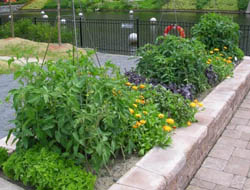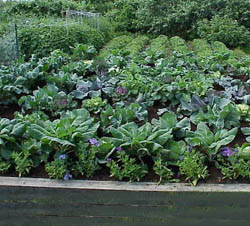
I have received many e-mails concerning the presence of lead in urban soils. Since September is prime time for beginning to build gardens at schools and community organizations, now is a good time to address the issue.
Lead is a naturally occurring element, like copper, iron, and gold, however it is highly toxic. Lead poisoning is a common pediatric problem. The heavy metal acts as a neurotoxin, and even minute amounts in a child's system can lower intelligence and slow neurological development. Children suffer more severe effects than adults from exposure to lead, and retain lead in their bodies much longer.
Most lead poisoning results from ingesting paint chips from walls or toys or from ingesting dust and dirt that contains high concentrations of lead. Very rarely are contaminated fruits and vegetables the culprit, but all precautions should be taken to limit lead exposure.

Because lead is not biodegradable or mobile, once it's in the soil it remains a long-term source of contamination. Gardeners should find out the history of the garden site before planting edible crops. Use the city lot number to check land use and ownership records at the local city hall. However, if you know the site was a former waste dump or something similar, then don't waste your time researching because it won't be suitable for growing food.
Even in areas with an acceptable history, there could be high levels of lead in the soil from paint waste and chips, automobile emissions, or other industrial sources. Unfortunately, many urban gardens are near older painted buildings, next to gas stations, adjacent to highways, or located in industrial zones. Basically, any garden in an urban environment is at risk, so the site needs to be examined carefully before planting.
Have the soil tested for lead. Some extension service offices, EPA offices, and private labs offer this service. Call them for instructions on collecting and delivering your soil sample. Inform them that you intend to grow edibles and need the soil checked for lead and other pollutants. Soils with lead levels below 300 ppm are typically deemed safe for growing vegetables. Most urban soils have levels in this safe-but-lead-still-present category.
Soil scientists use ornamental plants to help clean contaminated soil, a practice called "phytoremediation." Certain plants have the ability to pull heavy metals from the ground. In this way, the plants (phyto) help to remediate the soil. Ornamentals like sunflowers, thrifts, and blue fescue are some of the best at absorbing lead. Phytoremediation will not remove all the lead, but it can be a relatively inexpensive, aesthetically pleasing component of a professional soil remediation plan.
Although it is becoming a popular buzzword, phytoremediation is best left to experts. Because lead does not degrade, the metal simply moves from the soil to the plant tissues. If accidentally placed with other garden waste, this lead-filled debris would contaminate the whole compost pile. In fact, disposal of materials with heavy metals requires professional services. The best options for urban gardeners with more than 300 ppm of lead in the soil are to cover the ground, use raised beds, and leave phytoremediation to the scientists.
It is important for gardeners to remember that soils are not the only source of lead poisoning. Lead deposition from automotive and industrial emissions is common. Studies show that more lead is deposited on the leaves from urban dust than is absorbed through the roots from urban soils.
Even though the site may be technically deemed "safe," urban gardeners should still take extra measures to prevent contamination of their crops. According to expert Jaime Zaplatosch, education projects coordinator of Openlands Project, an urban conservation organization in Chicago, these important steps include:
In areas of high lead contamination, do NOT grow edibles in the ground. Instead, lay heavy-duty landscape fabric over the ground, construct raised beds at least 18 inches tall, and add fresh, uncontaminated soil. When building raised beds, choose natural materials over those that have been treated with preservative chemicals. Gardeners should take all precautions to help keep their vegetables free of toxins.
If you are not growing edibles, you don't need raised beds; however, for the protection of the kids, always lay landscape fabric and top it with mulch. Soils with lead concentrations that are not suitable for veggies can still grow great shade trees, flowering shrubs, and cut flowers.
These simple steps can allow urban gardeners to safely grow food and flowers. In most situations, the nutritional, psychological, aesthetic, ecological, and spiritual benefits of gardening will far outweigh the efforts needed to reduce the risk of contamination. Because our environment is not pristine, gardening in an urban area is definitely more challenging, but the rewards are that much sweeter.